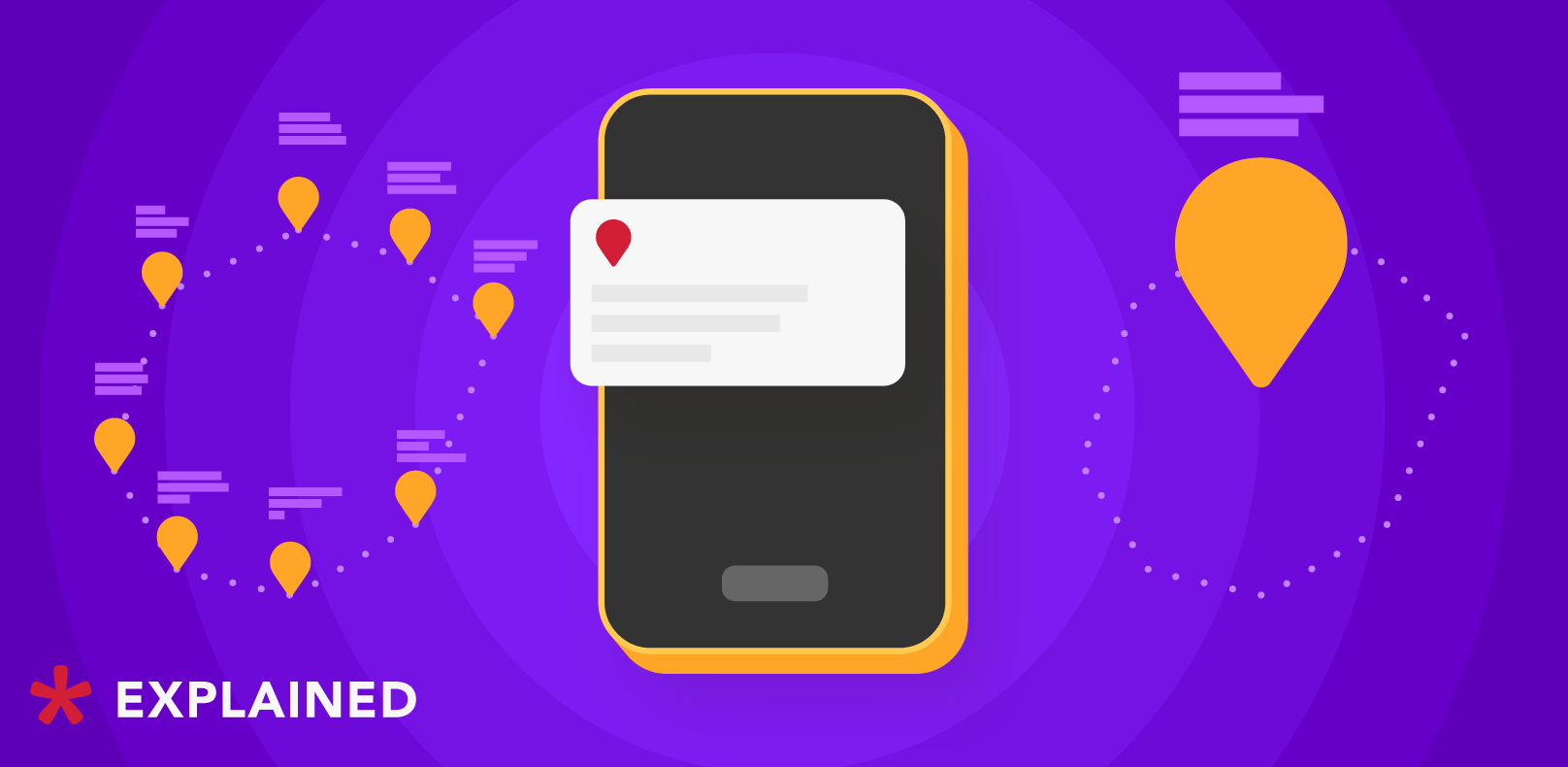
What is Geofencing? How to Use Geofencing vs Geo-Targeting?
Location data is a powerful instrument for increasing the efficiency of an advertising campaign. Services that allow advertisers to get closer to customers in a specified location can significantly change the engagement. This article highlights two location-based services: geofencing and geo-targeting, and answers the main question: how do they work and which one to choose.
-
What is geofencing?
-
What is the purpose of geofencing?
-
Geo-targeting
- Types of geo-targeting
- What is the difference between geofencing vs geo-targeting?
- Benefits of geofencing
- Customers are easier to reach
- Increase local sales
- Geofencing offers personalization
- Enhance brand awareness
- How accurate is geofencing
- What is mobile geofencing?
- Geofencing ads in a DSP
- To sum up
What is geofencing?
To put it simply, Geofencing is a location-based service that triggers actions in the mobile application or other software programs when the device enters a set location. For instance, these actions could be app notifications, text messages, coupons, security alerts, emails, or ads on social media. Using radio frequency identification (RFID), Wi-Fi, GPS, or cellular data, geofencing creates a particular area (zone) around a predetermined point on the city map, entering or exiting which triggers the stated above actions.
What is the purpose of geofencing?
Geofencing is used in many areas of modern life. It is used not only in marketing but also in aviation or in the airspace protection of strategic infrastructure facilities. Let’s deep into the main functions of geofencing.
Advertising and marketing: the technology allows companies to promote goods and services among users located near the brand. Geofencing advertising provides retail chains with assistance in sending special offers to users.
Logistics: the service provides functionality where the warehouse operator can be notified that a vehicle has arrived for loading or unloading through the application.
Collecting data about visitors: geofencing allows gathering information about location visitors. For instance, the store owner can evaluate the frequency of visits by customers to a particular outlet and the time they spent inside.
Smart home control: as soon as the user is in the geofence location, the system is able to give commands to the controller to perform certain actions (for example, turn on the lights or open the garage door).
Parental control: technology provides the service where parents will be aware that the child is leaving the school, yard, or any other selected location.
Reminders: through geofencing, the application can remind the user what he is going to do, approaching a particular store location.
Time tracking: with geofencing, managers can control the presence of employees at a workplace, the time of their arrival, and the time they leave.
Geo-targeting
Geotargeting is an effective marketing tool that allows showing ads based on the exact geographic location of users. The principle of targeting is widely used in contextual advertising networks, as well as in social networks. Advertisers can select specific countries, cities, areas, and even particular places on the map (for example, set up ads for visitors of a specific fitness center in the city).
Using geo-targeting in combination with other user characteristics makes it possible to find the most interested audience and exclude irrelevant ones.
Geotargeting is useful not only for the advertiser, it also gives the Internet users an opportunity to find the information they are interested in quickly. Search engines are set to the region the person is in by default. For example, when a user needs to know where the nearest cinema or cafe is, the search engine provides information about nearby establishments.
The commercial goal of geotargeting marketing is to “target” information and advertising messages to a relevant target audience. As practice shows, the return on geo-targeting ads is very high. The advertisers engage potential buyers, which leads to increasing their income.
Types of geo-targeting
Every month, geolocation technologies are improving greatly, more and more accurately determining where the user is. Although the technology still doesn’t provide the exact location of a customer, the development is coming along to this. Any marketing campaign with correctly set geo-targeting attracts more conversions. To understand the technology better, let’s take a look at the types of geo-targeting.
Local targeting: ads are shown within the same region.
Hyperlocal targeting: advertising is happening in a specific area, which is selected within 500 meters or indicated with particular addresses (shopping centers, theaters, airports, parks, business centers, etc.).
Advanced geographic targeting: ads are shown for queries that include the name of the display region. In this case, users from any area can see the advertising.
What is the difference between geofencing vs geo-targeting?
The issue is delicate since geofencing and geo-targeting are both used for location-based marketing, and both are powerful and efficient services to include in the programmatic campaign. Nevertheless, not only the technology but also the purpose of their work is different. To underline the mismatches of the two services clearly, let’s use the comparison table.
| Geofencing | Geo-targeting | |
| Purpose | Provide a highly relevant advertising experience to convert potential customers to specific locations quickly. | Provide a personalized advertising experience and increase brand awareness to get better conversions in the future. |
| The way it works | Set up a fence around a specific geographic location, which is quite narrow. | Set a broader geographic location, such as region, city, or country. |
| Target range | All potential customers entering the virtual fence can be targeted. After entering, they will see advertisements in mobile browsers, mobile applications or receive push notifications. | Only potential customers belonging to a certain category will be targeted. The geographic scope is broader and may include potential customers from specific regions, cities, or even countries. |
| Who uses it | Advertisers, business owners, event agencies | Almost every type of business |
| Location data | Geofencing is collecting location data and builds up a picture of a user’s location history. | Geo-targeting does not save location data. |
Benefits of geofencing
Customers are easier to reach
Geofencing provides an option to reach clients at a perfectly matching place and time. The technology allows advertisers to set the boundaries of the territory and initiate various actions when a mobile device crosses these boundaries. It’s easier to interest potential clients with an ad, considering the fact that they are nearby.
Using geofencing, advertisers contact customers through their mobile phones. This technique allows delivering promotion directly to customers’ hands.
Increase local sales
Local marketing helps to gain more conversions and grow the business, and local businesses were nearly among the first to research geofencing technology. Geofencing marketing is an excellent launch pad to get nearby leads through the business door. It allows building a better local marketing campaign.
Local restaurants, hairdressers, medical and dental offices, art organizations, and others can provide an online presence for their local customers. However, only a few clients outside of the area will use these services often.
Geofencing offers personalization
The feeling of being recognizable and unique appeals almost to every client. Personalized ads that are explicitly addressed to customers can hardly be left without attention.
Geofencing assists with understanding an audience better to make offers and promotions that attract clients constantly. What is more, advertisers can also understand which type of promotion produces greater interest and engagement through geofencing.
Enhance brand awareness
The advantage of geofencing marketing also lies in building brand awareness for the company. The more engagement the brand has and the more customers interact with the brand’s ads, the more likely they will be involved in doing business with the brand. Thus, geofencing marketing is profitable due to its’ location-based technology.
How accurate is geofencing
The technology combines GPS data, cellular data, and Wi-Fi data to ensure maximum geofencing accuracy. In environments like urban areas, where cell towers and Wi-Fi routers are everywhere, geofences can be accurate to 100 to 200 meters. In rural areas with the lack of required equipment, the accuracy can reach several hundred meters.
Important to note that geofencing provides the best accuracy with Wi-Fi turned on, and GPS services enabled on the mobile device.
What is mobile geofencing?
Geofencing has been operating both on IOS and Android for almost ten years.
The first to launch the service was iOS, where functionality for geofencing appeared in version 5 in 2011. The built-in Reminder App used geofencing to set up reminders triggered when the device owner entered a specific location.
On Android, geofencing became available two years later, in version 3.1 of Google Play services. However, at that time, the current version of the OS was 4.3, the new services also supported older versions – up to Android 2.2 (Froyo).
Geofencing is usually defined in the code of the mobile application. To use it, an administrator or application developer must set a virtual boundary. The area can be as large as a city or as small as a building. The boundaries can take different shapes. For simple cases, they can be circular, or for more complex cases, marketers can construct geofences in polygonal shapes.
This virtual border will then trigger pre-programmed actions (such as mobile alerts, in-app content, or data insights) specified by the developer for customers who have downloaded the related retailer or affiliated mobile app. A thriving geofencing solution should come with its API dashboard so that marketers can easily create, manage, and rearrange their geofencing.
Geofencing ads in a DSP
For digital advertisers, the great way to increase the efficiency of mobile advertising campaigns is to use geofencing. Furthermore, for this type of advertising campaign, advertisers often use demand-side platforms (DSP) to simplify the bidding and buying process for the mobile advertising space.
Many DSPs provide geofencing to help advertisers target their audience through mobile advertising.
DSP stands between advertisers and the advertising space. They automate the advertising space bidding and purchase process, allowing advertisers to display their ads to the right audience at the most favorable price. DSP provides a simple way for advertisers to bid for ad space and target ads.
In mobile advertising, DSP polls for information to study advertisers’ target audiences, measuring demographic information, online behavior, and other factors that may affect their reaction to advertising. Then, the DSP uses this information to determine what advertisements to display and in which advertising spaces. Using geofencing, DSP can go one step further and place ads based on the physical behavior of the target audience.
To sum up
Location-based services have already become the basic necessity for online advertising. Geofencing is a profitable and convenient tool for improving communication with consumers. By developing a geofencing application, a significant competitive advantage is added to a business. Understanding the difference between geofencing and geo-targeting and using them the right way can lead to prosperous marketing campaigns.




